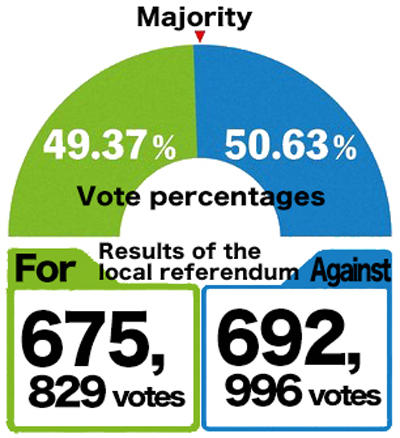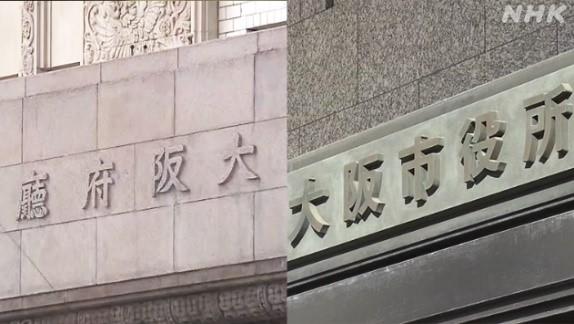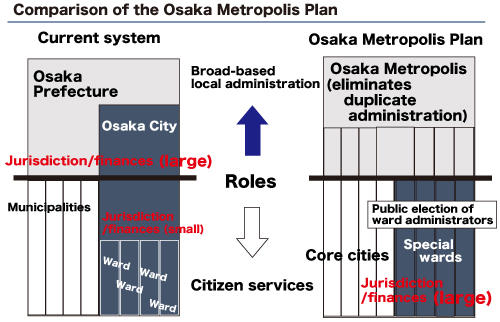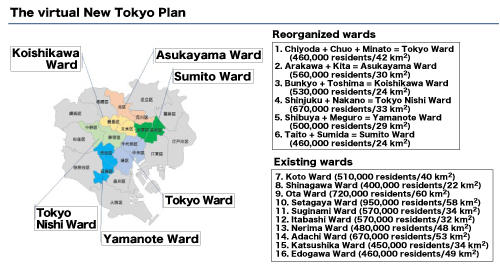Why Did Voters Reject the Osaka Metropolis Plan Twice?
Nobuo Sasaki
Professor Emeritus, Chuo University
Areas of Specialization: Public administration, local governmental autonomy
Results of the local referendum
On November 1, a local referendum was held in Osaka (population: 2,750,000 million) on the plan to abolish Osaka's city status and turn it into a metropolis with four special wards--also known as the Osaka Metropolis Plan--and was rejected by a margin of about 17,000 votes. This referendum, required when establishing of special wards in large cities with more than two million people, was based on the Law on the Establishment of Special Wards in Metropolitan Areas. On the day of the referendum, out of 2,205,730 eligible voters, voter turnout was 62.35% (compared to 66.83 in the previous referendum). The results of the vote were 692,996 against and 675,829 in favor.

Figure 11.1 Results of the local referendum
Why did the votes against the referendum outnumber the votes in favor again this time, albeit by a slim margin of 1 point, 49% in favor and 51% against? If you ask the citizens of Osaka, you will find that they had difficulties making decisions to the end. However, over the past five years, due to reforms carried out through a joint effort between the prefectural and municipal governments, the issue of duplicated administration, which had been seen as a problem, has been mostly eliminated, and the problems that threatened to overturn the current system have disappeared.
It was the result of the good personal relationship between the governor and the mayor, which has led to dampened interest in pursuing further reforms to institutionalize the decision-making framework so that it does not change according to the whims of future governors or mayors. This referendum was about a major institutional reform that involves abolishing the long-established city status of Osaka, and introducing the unfamiliar special wards. When faced with the choice, the majority of voters chose to maintain the status quo rather than to add potential concerns about the future. In September, public opinion leaned in favor of the referendum, polling 15 points higher than those who opposed it. Early indicators may have been optimistic, but as polling day approached, public opinion shifted toward being even, and on the day of the referendum, those who chose security over change outnumbered those who embraced the change. The result was ironic in the sense that the successful advances of reforms led to the rejection of the final major systemic reorganization.
Proposals for this metropolis plan started in 2010, when the local party Osaka Restoration Association was formed. Later, a promotion bureau was established through a joint effort between prefectural and municipal governments, and the authorities of Osaka City and Osaka Prefecture designed the new system. However, the residents decided this time to reject the plan, and it was decided that Osaka would retain its city status. Five years ago (May 17, 2015), the Osaka Metropolis Plan was rejected by a margin of about 10,000 votes. This was followed by negotiations to amend the plan, finally arriving at a referendum, which was again rejected. The last time the plan was rejected, Toru Hashimoto, then mayor of Osaka, claimed responsibility for the failure and retired from politics. This time, the current Osaka Mayor Ichiro Matsui, the leader of the Osaka Restoration Association, announced his intention to retire from politics when his term as mayor expires in April 2023.
The referendums in Osaka have resulted in the loss of a series of leading reformist politicians. Is this decision-making process a result of deciding on policies and reform proposals with the individual votes of citizens by pursuing the will of the people through direct democracy, in a system built on indirect democracy? What I saw in the opposition movement was not an attempt to present a counter-proposal, but rather a deluge of misinformation about the proposed plan, such as how it would reduce the quality of government services, or that it would cost too much money, spread by the unlikely coalition of incompatible parties: the Liberal Democratic Party and the Communist Party. This seems to have led to the votes against the referendum outnumbering the votes in favor. The question is, whether this really reflects public opinion. Is this not a form of a bad brand of populism?
If the votes had been in favor of the referendum even by a slim margin, Osaka would have lost its city status on January 1, 2025 after a transition period of about four years. The four special wards would have been created, with the Kansai-Osaka Expo scheduled to take place for six months from May to November of the same year. This sequence of events was stopped before it could begin.
Halting the decline of Kansai's influence
Why, for the past ten years, has Osaka insisted on pursuing reforms? The city was known as the Manchester of the East during the Meiji era and prospered as Japan's largest commercial city, but for the past half-century since the Osaka Expo in the early 1970s, there has been much talk about the decline of Osaka's influence. To turn the tables on this trend, the plan was to change the governmental structure of Osaka, with the special wards taking charge of basic government services, and the prefectural (or metropolitan) government taking charge of broader-based local government policies. The governor would take command over broad, far-reaching policies, such as growth strategies for the metropolitan area.
Over the past decade, Osaka City and Osaka Prefecture have pursued joint efforts to enact various reforms to its governmental structure, including privatization of the municipal subway system, integration of Osaka Prefecture University and Osaka City University, and abolition of duplicate administration. The city and the prefecture have also been working effectively to deal with the coronavirus crisis. In line with this trend and their efforts to succeed in realizing the metropolis plan, there have also been accelerated efforts to restore the status of Kansai region such as plans for sub-capital status and preparations for the 2025 Expo. Will this decision, which halted these plans as they were gaining momentum, plunge Kansai once again into declining relevancy? Did those who voted for the referendum foresee this calamity and thus supported the reforms, while those who opposed it wanted to maintain the status quo as part of a resisting force?
What is the Osaka Metropolis Plan?
What is the background to the reforms designed by Osaka Prefecture and Osaka City, which were first initiated by the Osaka Restoration Association? Let us review what the proposed metropolis plan is once again.
The Osaka Metropolis Plan refers to the plan to abolish Osaka's city status and replace it by integrating the local government with Osaka Prefecture (the metropolis) and creating four new special wards for the basic administration of the city, with construction of a system of elected ward administrators and ward councils to enhance the autonomy of residents. There are two major reasons for pursuing these reforms.
The first reason is to eliminate the waste produced by the duplication of administration by both the city and the prefecture of Osaka, a problem that has continued for more than 70 years since the war. The goal was to solve the problem of a situation with no clear leader, where the two heads of government (municipal and prefectural) in charge of similarly sized finances were in perpetual conflict.

Photo: The prefectural and municipal governments of Osaka in conflict
For a long time, the Osaka municipal government was at the center of operations, and even though the prefectural government was responsible for the administration of Osaka Prefecture as a whole, it had very little power over the affairs of Osaka City itself (photo above). As a result, there were many similar facilities set up separately by the prefectural and municipal governments within Osaka's narrow city boundaries, which led to an intolerable state of duplicate administration.
Wasteful investments led to economic difficulties, resulting in insufficient funding for education and other sectors, in turn leading to a decline in the academic performance of elementary school students to nearly the worst in the country. With each government having broad authority, mayors and governors were in perpetual conflict. They had different visions for Osaka, which led to the continued confusion and stagnation of Osaka. The main purpose of the Osaka Metropolis Plan was to put a stop to these problems at the source.
Another reason was to change the trend of the extreme concentration of influence in Tokyo, and to remake Japan with a sort of dual-lens structure. In order to manage crises effectively to protect the country from catastrophic disasters, such as the coronavirus pandemic and the Tokyo near-field earthquake that is expected to hit in the future, the country must decentralize and form a new sub-capital somewhere in Japan that is physically separated from Tokyo. Osaka is the most suitable place to locate this sub-capital.
A sub-capital changes the country's unipolar structure, and serves as an alternative to the capital in the event of a disaster or terrorist attack on Tokyo, the official capital. To this end, the vision entails designating Osaka as a sub-capital, with one-third of the main ministries relocating to it, and stationing the deputy ministers there. The legislative branch would be divided into two sections through methods such as holding the spring and autumn sessions of the Diet in Tokyo and Osaka, respectively. Soon, the maglev train will connect Tokyo and Osaka, making it possible to travel between the cities within 80 minutes.
The heart of the Osaka Metropolis Plan
At the core of the Osaka Metropolis Plan is the transition to a metropolitan ward system. This plan has two elements: it transforms the city of Osaka into special wards, while also changing Osaka Prefecture into the Osaka Metropolis and strengthening regional policies. This is what is known as the metropolitan ward system. This system of metropolitan management unifies the tools of control over metropolitan management, while clearly dividing the roles between broad-based government policies and basic government services. The broad-based regional government (the metropolitan government) and the basic municipalities (special wards), which take on these roles, manage the city as a whole with regard to the administration. This kind of system is commonly seen in major metropolitan areas around the world, including New York and London.
Specifically, in the case of Osaka, instead of being a single ordinance-designated city of 2.75 million residents, it would be divided into four special wards, each with a population of about 600,000 to 750,000--similar to how core cities are structured. This means that the basic local governments would be managed by a political initiative led by publicly elected ward administrators and publicly elected councils (see the figure below).

Figure: Comparison of the current system with the Osaka Metropolis Plan (created by the author)
Regional administration, which was previously divided between the prefecture and the city, will be consolidated under the Osaka Prefecture (Metropolis), and the Osaka Prefectural Government (metropolitan government) would exhibit strong leadership while also considering the needs of the Kansai region as a whole.
Since the metropolis plan itself was rejected, there is no longer a procedure to change Osaka into Osaka Metropolis, but even if it had been approved, the referendum would not automatically change the name of Osaka Prefecture to Osaka Metropolis. The law would have to be amended to change the name, which would likely have required another referendum by the 8.8 million residents of Osaka Prefecture.
Such referendum would take place during the gubernatorial and mayoral elections in April 2023. If the referendum were to pass and Osaka Prefecture become Osaka Metropolis, the current structure of Japan with one metropolis (to), one administrative region (do), two metropolitan prefectures (fu), and 43 prefectures (ken) would change for the first time in 80 years to a structure with two metropolises (to), one administrative region (do), one metropolitan prefecture (fu), and 43 prefectures (ken). This would require the rewriting of elementary and middle school social studies textbooks.
The 23 wards of Tokyo will also need to be restructured
Even though the referendum was rejected by a narrow margin, nearly half of Osaka's residents support the Osaka Metropolis Plan. The idea of establishing special wards in Osaka, with authorities similar to those of core cities, would be attractive to Tokyo's special wards, which have been advocating for the expansion of their own autonomy. Moving forward, whatever happens in Osaka is no longer irrelevant to affairs in Tokyo. It will be the start of a new movement. For a long time, the 23 special wards, which have been pressing for the transfer of authorities and financial resources to create a stronger basic local government, and the Tokyo metropolitan government, which has been pursuing reorganization of the special wards, have been stuck in an unending debate over these powers and monetary resources. How do we address those concerns in the future, and what kind of compromises and agreements will be reached?
The current structure of the special wards of Tokyo, in which each ward has the authorities and financial resources equivalent to those of a general city needs to be reorganized into a structure of special wards with 400,000 to 700,000 people each, which is close to a core city (status between general city and ordinance-designated city). In order to further enhance the Tokyo Metropolitan area, these efforts and transferring of authorities, financial resources, and administrative work from the Tokyo Metropolitan Government will be necessary.
The current situation of various scales of wards similarly performing fully functional administration needs to be reset. Major reforms will become essential for redirecting the effects of reductions in indirect costs and other factors to enhance services, and such reforms will ultimately be beneficial to citizens.
If we were to reorganize the special wards into wards of 400,000 to 700,000 people, I propose the following plan.

Figure: Tentative New Tokyo Metropolis Plan (created by the author)
The 10 wards with over 400,000 residents (Koto, Shinagawa, Ota, Setagaya, Suginami, Itabashi, Nerima, Adachi, Katsushika, and Edogawa) would remain unchanged, while the remaining 13 wards would be reorganized into six wards, transforming the 23 wards of Tokyo into 16 wards. For example, Tokyo Ward (Chiyoda + Chuo + Minato), Asukayama Ward (Arakawa + Kita), Koishikawa Ward (Bunkyo + Toshima), Tokyo Nishi Ward (Shinjuku + Nakano), Yamanote Ward (Shibuya + Meguro), and Sumito Ward (Taito + Sumida) will all be wards with roughly 500,000 residents each.
There would be 16 special wards with roughly equal population sizes, and similar scales of public finance.
Establishing the third special council--a new shape for the nation
Osaka's reforms have failed due to the whims of popular will, but this is not the end of the story. Other than Osaka, with a population of 2,750,000 million residents, there is Yokohama with a population of 3,750,000, Nagoya with a population of 2,320,000, in addition to the ordinance-designated cities of Sapporo, Fukuoka, Kawasaki, Kyoto, and Kobe, all with populations of around 1,500,000. All of these cities are experiencing the problems of duplicate administration and two-dimensional politics in some shape or form. Japan's large cities form the backbone of the country, and are acting similar to city-states. The era in which these cities are treated as mere exceptions to the municipality model is over. Serious debate must take place about what the metropolitan system should look like. The negligence of the government to avoid these reforms is unacceptable.
It has been 150 years since the abolition of feudal domains and the establishment of prefectures. The survival of this country, which is experiencing population decline, depends on wise reorganization of government structures that were built in the Meiji era. Even though the Osaka Metropolis Plan was rejected, the reform process leading up to this referendum will have a major impact on Japan's major and regional cities. We as a nation should take this opportunity to strengthen the authorities of the basic local governments while also starting discussions on abolishing prefectures and creating states to replace existing prefectures with states that have more autonomy over regional policy-making.
Tokyo and Osaka would serve as quasi city-states with the functions of the capital and the sub-capital, respectively, and the nation will be restructured to comprise about 10 states. That is, the current structure of 47 prefectures would transform into 10 states and 2 quasi-city states. In order to pave the way for this new shape of Japan, the government should establish the third commission for administrative reform.
This should be the historic mission of the administration of Yoshihide Suga, who came from the countryside and rose through the ranks to become a member of the Diet for the major city of Yokohama, then going on to become prime minister. This is where we find ourselves as a nation today, at a major crossroads where these decisions must be made.
Nobuo Sasaki
Professor Emeritus, Chuo University
Areas of Specialization: Public administration, local governmental autonomyNobuo Sasaki was born in 1948. He graduated from the Graduate School of Political Science at Waseda University and earned his Ph.D. in law at Keio University. After working at the Tokyo Government Office for 16 years, he taught as a professor at Seigakuin University in 1989 and at Chuo University from 1994 to 2018. During this time, he worked as a visiting researcher at the University of California and taught as a lecturer at Keio, Meiji, Nihon, and Saitama Universities. He was a member of the Local Government System Research Council (the 31st term), a member of the Science Council of Japan (the 22nd and 23rd terms), and a special advisor to the Osaka prefectural and municipal governments.
Currently, he is a professor emeritus at Chuo University, a guest professor at the Graduate School of Project Design, the board chairman of the Nihon Kunizukuri Kenkyujo (the Japan Nation Building Research Institute), a special advisor to the Osaka prefectural and municipal governments.

Among his many publications are: Kono Kuni no Tatamikata (How to Reform This Country), Shincho Shinsho; Aratana 'Kuni no Katachi' (The New 'Shape of Japan'), Kadokawa Shinsho; Oiru Tokyo (Aging Tokyo), Kadokawa Shinsho; Chiho Giin no Gyakushu (The Revenge of Local Assembly Members), Kodansha Shinsho; Tochiji (The Tokyo Governor), Chuko Shinsho; and Tocho (The Tokyo Government Office), Iwanami Shinsho.









